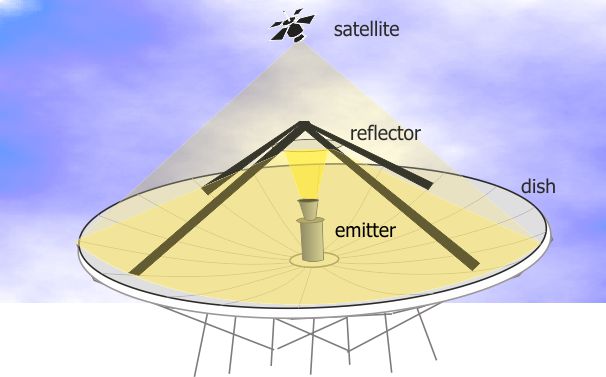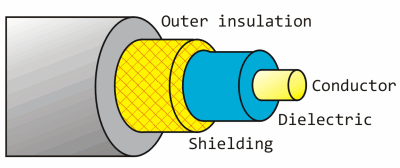Freesat reception - all about dishes
 Brian Butterworth published on UK Free TV
Brian Butterworth published on UK Free TV Satellite reception has both advantages and disadvantages compare with terrestrial (aerial) reception.
By using much higher frequencies (gigahertz, compared to terrestrial televisions megahertz) more transmission channels called transponders (the satellite equivalent of multiplexes) can be provided. For example, there are only six Freeview multiplexes, but Sky or Freesat users can access two hundred satellite transponders.
Aside from exceptional weather conditions (very heavy rain for example) digital satellite provides stable pictures and audio. Where Freeview transmitters are no more than 732 metres above sea level, the geostationary satellites used for television are 35,800,000 metres above the equator so reception is possible even where buildings, trees and hills make terrestrial reception impossible.

The downside of the transmitters being 22,300 miles up in the air is that the signals are very, very weak - so standard TV aerial is of little use. When the signals are sent to the satellites, huge dish transmitters are used to uplink the signal to the satellite. These are tens of metres from side to side, and feature an emitter that generates the signal, which is first bounced of a mirror (called a reflector) and then off the surface of the parabolic dish.

There are many satellites in the sky over the equator. Often these are in clusters over a particular position, for example there are four used for UK television are at 28.2 degrees east. There is another cluster over the 19.2 degrees east positions that are used for German television.
To receive these very weak signals from the satellite, it is necessary to use a dish for reception too. By using a reflective dish, this concentrates the signals onto a small device called a LNB. This is held in front of the dish by a metal arm.

The size of dish for reception is typically much smaller; often 60cm to 100cm in diameter, but the exact size depends upon the transmitting satellite transponder. To keep the transmission power levels down to levels that can be powered by the satellite's solar panels, each beam is focused on a particular area of the Earth's surface. If you are trying to receive the signal at the centre of this zone, a small dish is required. At the outer edges, you may need a 5 metre dish. Maps of these zones are provided by the satellite companies, and are called satellite footprints.
When the dish is installed it must be aligned carefully as the signal is very weak. The installer needs to know the inclination and the azimuth from the ground location to the satellite. If you install yourself you will find that there are markings on the dish that are used to point the dish in the correct position. It is important that the view of the satellite will not be blocked, so must take into account leaves growing on trees and potential building works.
For many people the LNB will have a single cable connected to it, however if you have Sky+ or a multi-room installation the LNB package will actually contain four receivers a quad-LNB. Unlike terrestrial television where you can split the aerial cable to feed more than one Freeview box or television set, with satelite reception you cannot. So, a Sky+ box with two receivers (so you can watch one thing and record another) has two cables connecting the box to the dish.
The cable that connects the dish to the receiver must be satellite grade cable. Whilst this looks superficially like the cable used to connect and aerial to a television, a higher grade cable is required for satellite reception.
Here is an image of a co-axial cable. This sort of cable is used to connect any type of receiving aerial to the reception equipment.

RG6, PF100 and PH100 are all types of coax cable that are suitable for the very weak signals that are received by a satellite dish. (The power is the same as you would receive from a one-bar electric heater on the moon).
The conductor in the centre passes the signals received from the dish to the set-top box. This is made from steel in RG6 cable, and from copper in the RF100 and PH100 types. This makes RG6 less suitable in the UK where rain can damage the cable.
The shielding is responsible for keeping unwanted external interference from damaging the signal. In the cheaper cable this will be a foil wrap, in better specified cables this is a braid (or mesh) of copper wires. The sheild in the RF100 covers 58% of the cable.
The non-conducting layer between the shield and the conductor is called the dielectric. This can be either a solid (RG6), foam (RF100) or air-spaced (PH100) dielectric. This makes the cables progressively more flexible (ie bendy without damage).
10:32 PM
Elaine Could you just clarify that we are talking about Freesat here? We don't normally use splitters for satellite receivers but often do for terrestrial (Freeview) aerials. With satellite receivers it is more normal to use a dual or quad LNB on a dish which would give 2 or 4 outputs for separate tuners. Have you tried swapping the receivers round as this might help identify where the problem is. Also if you can reach the dish easily and you have a dual LNB you could try swapping the cables round again to help identify where the problem is.
| link to this comment |
11:40 PM
Elaine Campbell: Irrespective of what mode of reception you might be referring to i.e: Freesat, Sky or Freeview (via a normal aerial) then for test purposes you should try connecting your secondary box into the feed used by your living rooms equipment.
Also, should you be referring to a Freeview box then a post code or one from nearby (e.g: a shop / Post Office) is required for the purpose of assessing the signal levels expected on the Island you reside on, as without same its impossible to access data connected with the transmitter being used.
If though you are referring to satellite reception then this info is not required.
| link to this comment |
9:44 AM
My sky box has packed up but I have a Ross sat receiver is it just a matter of changing boxes still using the sky dish without realigning the dish
Regards John Brownlie
| link to this comment |
10:08 AM
John Brownlie : Yes, but remember that your Ross box is not a dedicated Freesat device and as such the programme channels are not likely to come up in the correct EPG order such as they would on a Freesat device, this requiring you to spend some time shuffling them around so as to resemble a Freesat guide.
| link to this comment |
9:34 AM
I am using a Ross receiver from B &Q, it was working fine apart from any HD channels that were pixilated, I re-aligned the dish and am now getting about 57 Q and 99 L, but when I scan the box freezes and I have to turn it off. What can I do to stop it freezing during scan?
| link to this comment |
6:35 PM
can i fit a sky quad lmb from my old sky dish on to a 100cm dish with no signal showing. is the LMB compatable on a 100cm dish. i have used sat find but with no luck,
thank you
christy
| link to this comment |
7:35 PM
christy condron: Provided that the 100cm dish had a standard 40mm LNB mounting clamp and which had not been altered (bent) in any way then there is no reason why the ex-Sky dishes quad LNB should not work.
That said, these large dishes are very critical to align and especially so for anyone who is not acquaint at this sort of thing, (meter or not!) also are you sure that the dish in question was not previously being used for reception at 19.2 degrees rather than 28.2?
Its also assumed that you did use more than one port for testing? as Murphy's law usually dictates that out of the four ports thats available a person will choose the defective one to use for tests.
| link to this comment |
11:56 PM
how do I change my password
to get chanel 4+1 on freesat
| link to this comment |
2:03 PM
Lester Barker: Channel 4+1 has been on Freesat practically since it launched - it went free-to-air in September 2008. You should find it at channel 121.
If it doesn't appear in the guide, try turning the box off and back on. If it still doesn't appear after turning the box off and back on, look for a Factory Reset or Default Setting feature. Typically, the default password for this is 0000 or 1234. If neither of these work, or the box's manual doesn't say, contact the manufacturer to find out how to reset the password.
There are six variants of Channel 4+1, which have different adverts for different parts of the UK. They are all carried on the same frequency. The box uses the postcode you enter to decide which variant to put in the programme guide.
If channel 121 does appear in the guide, but you don't see anything when you select that channel, even after doing a reset, it indicates a problem either with the vertical element in the LNB (the box on the arm of the dish), or with the signal that selects vertical polarization. Make sure you haven't split the cables from the dish to the box - trying to connect more than one box to the same feed cable causes a conflict with the selector signals that the boxes are sending to the dish. Each input on each satellite box must have its own separate cable to the dish, and its own input on the LNB.
| link to this comment |
5:36 PM
Sorry I am a bit of a luddite. I have just given up Sky and bought a Freesat+ box, (Humax Foxsat HDR). I have a damaged coaxial from the dish to the box consequently if I am recording a programme I have to also watch that channel. I have bought a twin coaxial Cable from Amazon, does it matter which of the four connectors at the dish I connect to.
| link to this comment |